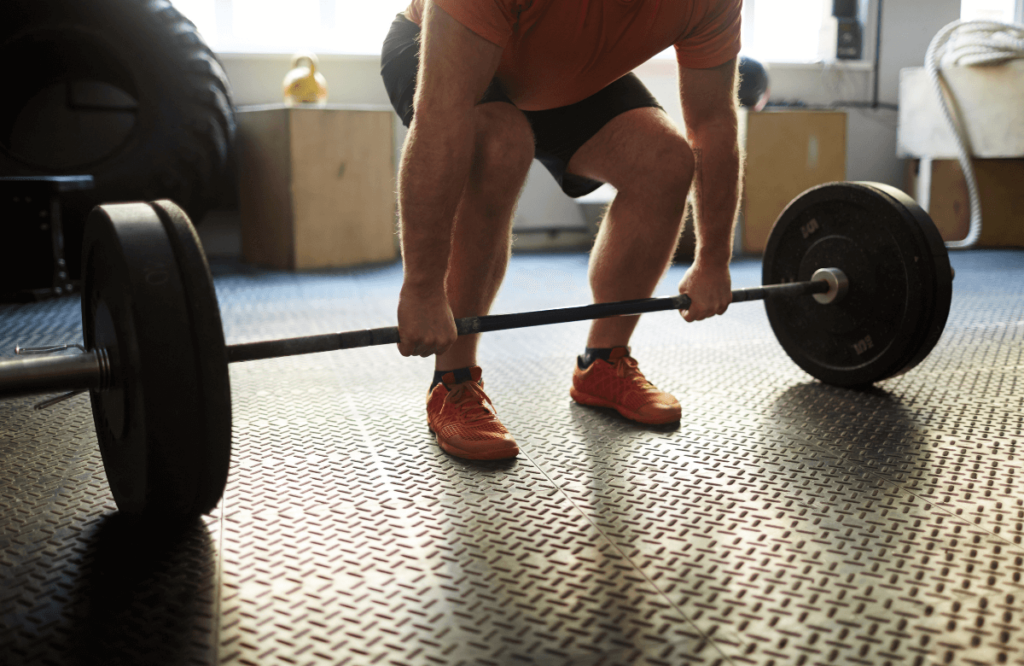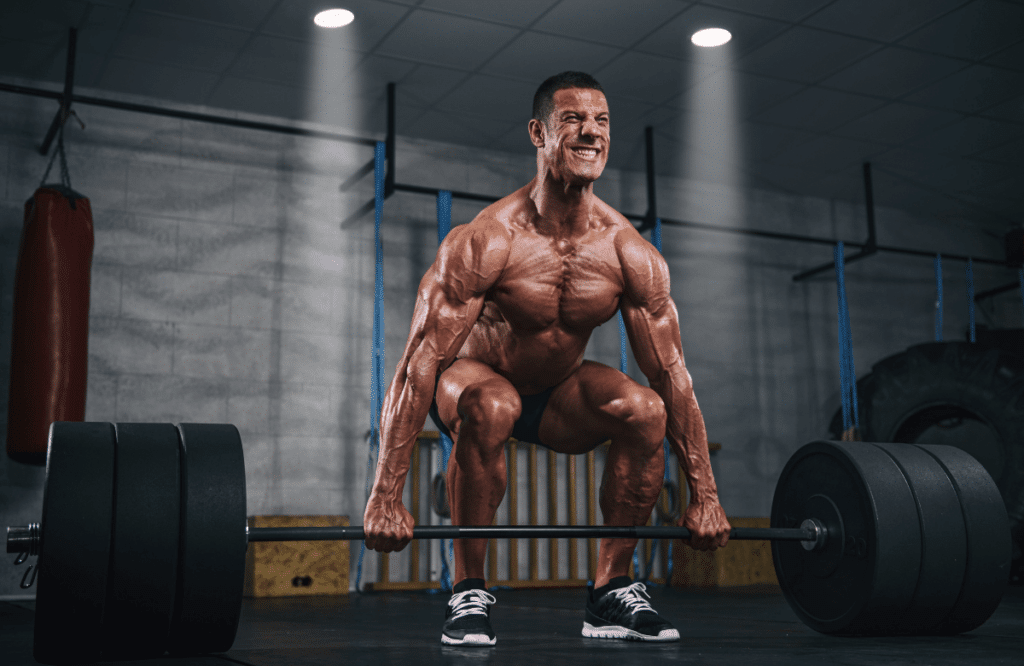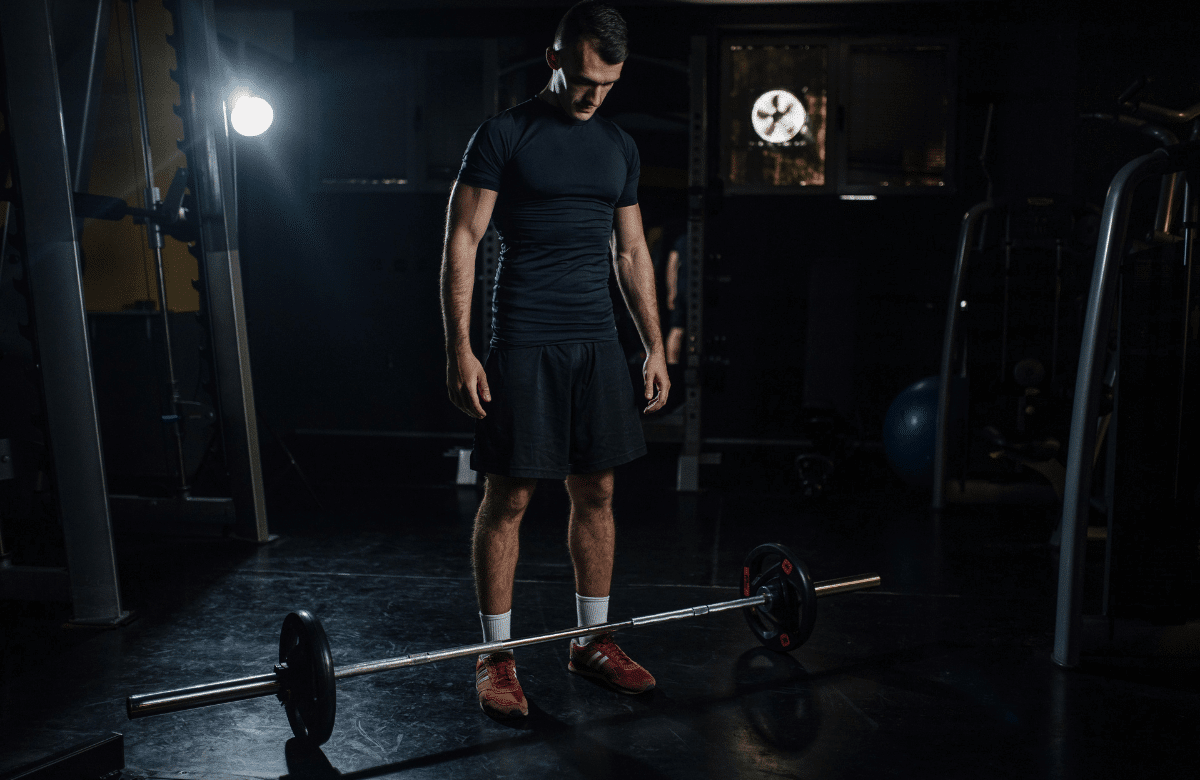You’ve probably seen the biggest lifters in your gym perform the deadlift and rack pull. These heavy lifts can be ideal for increasing strength and building mass. But which lift should you program?
Let’s take a deeper look at the advantages, disadvantages, and best-use cases for rack pull vs. deadlift.
So, you want to get big? If you answered yes, you’re probably familiar with the deadlift and rack pull. These movements utilize several muscles and are incredibly effective at developing the upper and lower body.
You’ll need to understand the differences before deciding which exercise fits your goals. Here’s everything you need to know.

Jump to:
What Is a Rack Pull?
The rack pull is a deadlift variation with a shorter range of motion. The movement focuses on the top end of the deadlift by raising the bar off the ground. The barbell is typically lifted off the ground by setting it on the safety pins of a squat rack or block, similar to the block deadlift.
Raising the barbell off the floor allows you to load more weight than you would normally, allowing you to strengthen the glutes and spinal erectors.
It’s common to perform rack pulls from above knee height, but many lifters will start just below or above the knee. The decision comes down to the range of motion you want to train.
Lifters who struggle with the top end of the deadlift can use the rack pull to strengthen the weak points of their technique. Many powerlifters include the rack pull as an accessory exercise to enhance their deadlift.
Rack Pull Benefits
- Rack pulls can be used as an overload exercise, increasing strength.
- A shorter range of motion allows you to use heavier weights than the conventional deadlift.
- It can emphasize weak points in the top portion of the deadlift.
- Rack pulls activate the glutes and back muscles
- Offers variety in training stimulus.
- Rack pulls are a fantastic grip strength exercise.
- It can protect the floor from the impact of heavy weights if you have a home gym.
Block Pull Variation
Your local or home gym might not have a squat rack available. In these cases, you can perform block pulls. Block pulls are a variation of the rack pull and require you to place the barbell on blocks. The movement is also less likely to damage the barbell or the rack, depending on the situation.
You can use specially designed blocks, or you can place the weight on several stacked bumper plates to around knee level.

What Is a Deadlift?
As you might know, the deadlift is one of the three big compound movements alongside the squat and bench press. The exercise is used by powerlifters, bodybuilders, Olympic athletes, and gym enthusiasts alike.
Why do so many individuals use the deadlift, you ask?
It trains functional strength in daily activities or sports, like jumping, sprinting, picking things up, and bending over. The deadlift requires a full range of motion compared to the rack pull. You lift the weight off the floor, meaning the quads are activated more.
You’ll use several different muscle groups when performing the deadlift as a compound movement. This means you may not pull as much weight as the rack pull, but you’ll activate more muscles.
Benefits from Deadlift Training
- The deadlift is a compound movement that strengthens multiple lower and upper body muscles. Trains the entire body.
- Develops functional strength.
- It’s terrific for building strength and mass in the lower body.
- It’s a fantastic option if you don’t have much time, as it uses several muscle groups.
- Deadlifts can improve jump performance.
- It may decrease muscle loss in older individuals.
- Deadlifts can increase bone density which is helpful for contact sports and reducing the risk of injury.
- It’s a fantastic functional movement for rehabilitation.
Rack Pulls vs. Deadlift: Muscles Worked
The deadlift and rack pull work similar muscles but have different advantages and best-use cases. Understanding the different muscles that each exercise activates will help you determine how to program each movement. Here’s a deeper look at the two exercises.
Rack Pull Muscles Worked

The rack pull is similar to a standard deadlift but doesn’t include the knee extension and has a partial range of motion. Instead, it works the following muscles:
- Glutes
- Adductor Magnus (inner thigh)
- Spinal erectors
- Hamstrings
- Lats
- Trapezius muscles
- Rhomboids
- Hands/forearms
The rack pull primarily uses the hip joint, which requires the glutes and muscles in the inner thigh. You can activate the spinal erectors more or less depending on the angle of your torso; bending over more will use more of the spinal erectors.
The hamstrings aren’t activated as much as the other muscles, but they come into play when your glutes and inner thigh need support. The lats, traps, and rhomboids act as stabilizing muscles to keep the barbell steady.
Finally, the rack pull can be a fantastic grip strength exercise as it targets the hands and forearms. Using a heavier weight than your standard deadlift will work these muscles much more and improve your traditional lifts.
Deadlifts Muscles Worked

The traditional deadlift uses a fuller range of motion compared to the rack pull and activates the following muscles:
- Quadriceps
- Glutes
- Adductor Magnus (Inner Thigh)
- Hamstrings
- Erectors
- Lats
- Traps
- Rhomboids
- Hands/forearms
The traditional deadlift uses the quads much more than the rack pull due to the knee bend in the starting position. Depending on your body type and fitness level, the glutes and spinal erector may come into play more.
Bending over more will activate the glutes and spinal erector more. Taller Lifters with longer legs may activate these muscles more than individuals with a more upright stance.
Deciding Which Movement to Program
The rack pull and the traditional deadlift train similar muscles but can be utilized for different fitness goals. So, when and how should you program the movements? Let’s look at some general suggestions to help you brainstorm your following routine.
Use Deadlifts as a Primary Compound Movement
Depending on your fitness goals and experience, the regular deadlift might be one of your primary compound lifts. The deadlift is a compound exercise and targets multiple muscles in the lower body and back. It can help you improve your strength, muscle mass, and physique when performed correctly.
For example, you might perform traditional deadlifts twice a week on a four-day schedule. On the other two days, you can use variations to target specific muscles or portions of your technique.
Program the Rack Pull to Enhance Your Deadlift
The rack pull is an effective exercise to enhance your barbell deadlift. It can improve the top portion of your deadlift technique, muscle mass, and grip strength. If any of these areas are weak points, use the rack pull throughout your schedule.

Program the Deadlift If You Don’t Have a Specific Goal
Stick with the deadlift if you’re a beginner or don’t have a specific goal in mind. The deadlift is a full-body exercise and uses more muscles than the rack pull. It can be better for increasing general strength and mass. Programs like Starting Strength are an excellent place to start if you don’t have specific goals or compete in events.
Use the Rack Pull to Build Mass
The rack pull is extremely useful for building back mass. The effects from the rack pull might give you a more dense back musculature. It’s an effective movement that can bolster your efforts on machines if you’re doing bodybuilding routines.
That said, you shouldn’t exclude machine-based exercises or high-rep movements if you’re doing a bodybuilding routine. These exercises are equally important and will help fill your program.
Program Rack Pulls to Improve Grip Strength
Rack pulls typically use higher loads than the conventional deadlift, which requires more strength from the forearms and hands. The higher load can enhance your grip strength, which will positively impact your deadlift and other movements.
Depending on your program, you might include rack pulls as a dedicated portion of your grip strength training routine. Rock climbers and athletes who need grip strength can also benefit from the rack pull.

Rack Pulls vs. Deadlift Rep Range
Besides picking a movement for your training routine, you’ll also need to decide on the rep range. The reps for your workout routine will depend on your fitness goals and can be adjusted accordingly. Let’s take a look at some typical ranges to keep in mind.
1-5 Rep Range to Develop Muscle Strength
It’s best to stick with a low rep range if your goal is to develop muscle strength. Somewhere between 3-5 reps per set are recommended. For example, you might perform five reps of deadlifts for three sets. That said, you’ll need to lift heavy weights that are still manageable. Manageable loads can be increased over time and help you reduce the chance of injury.
1-8 Rep Range to Prioritize Technique
The 1-8 rep range can provide the balance between building muscle strength and muscle size.
You’ll typically need to use lighter weights than the 1-5 range, but you can still lift reasonably heavy loads. Your muscles will have more time under tension, and you can also use the extra reps to practice your technique.
6-12 Rep Range to Increase Muscle Size
The 6-12 rep range is ideal for muscle hypertrophy and increasing muscle size. For example, you might perform 6-12 reps of deadlifts for five sets. That said, you’ll need to use moderate weights to gain size. Lightweights over 12 reps will do more for your muscle endurance than size.

Frequently Asked Questions (FAQ)
Are Rack Pulls Better than Deadlifts?
Rack pulls and deadlifts train similar muscles in the upper and lower body. That said, the deadlift has a fuller range of motion and targets more muscles in the lower body. The rack pull uses less knee flexion and can improve the top portion of the deadlift.
Should I Go Heavy on Rack Pulls?
Rack pulls are generally performed with heavier weights than the normal deadlift. The partial range of motion allows you to use heavier loads, which can significantly increase your grip strength and forearms. It’s an overload exercise used to build muscle and mass.
Are Rack Pulls Worth It?
Rack pulls are definitely worth it! You can program rack pulls as a deadlift variation, back exercise, grip strength exercise, or as a way to improve your deadlift form. It targets several muscles, including the glutes, inner thigh, lats, back, and forearms.















